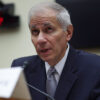
Some $1.3 million has been diverted from taxpayer funded city infrastructure projects for esoteric stop signs and other public art works. (Photo: Watchdog MN Bureau Photo)
ST. PAUL, Minn. — St. Paul may be predictably progressive, but the powers at City Hall enthusiastically embrace the “1 percent.” The 1 percent, that is, of costs automatically taken off the top of local government construction projects, under a city ordinance mandating taxpayer-funded public art.
Form counts as much as function in city infrastructure projects. “The city council believes planning and development decisions should give aesthetic and social value equal weight with any project’s functional and economic values,” according to the Public Art Ordinance Program guidelines.
Embedded in public works department offices and equipped with taxpayer-provided phones and computers, two artists-in-residence, paid by the nonprofit Public Art Saint Paul, collaborate with city engineers and architects on capital construction projects — from stairways to stadiums.
The most visible publicly funded art on display stops drivers and pedestrians in their tracks — by design. Dozens of newly installed floral-themed stop signs, commissioned by resident city artist Marcus Young, elicit double- and triple-takes.
“Marcus concluded that, if a stop sign post is a matter of life and death, it is even more important that the stop sign post be beautiful,” according to Art Place America. “… It should speak to something beyond simply maintaining our life; that the stop sign post presented an opportunity to create something that keeps our bodies safe while nourishing our souls.”
The $110,000 public arts project features traditional stop signs atop curved rusty iron posts shaped like stalks that sprout metal petals, leaves and floral motifs designed by artist Lisa Elias. The floral signs averaged about $1,000 apiece, including administrative, production and installation costs. Typical stop signs cost about $250 to replace every 10 to 15 years and don’t generally need new posts, according to MnDOT.
A master list of projects undertaken since passage of the 2009 ordinance indicates $1.3 million in taxpayer funding has been budgeted for public art works incorporated into infrastructure projects such as bridges, boulevards, buildings and public places. A 79-page technical manual lays out the policies and procedures for artists to follow.
Case studies posted online show budgets up to $50,500 for artwork on a bridge, $90,000 for a digital media set-up at a community and recreation center and $170,000 for creative enhancements at the new St. Paul Saints’ stadium.

























